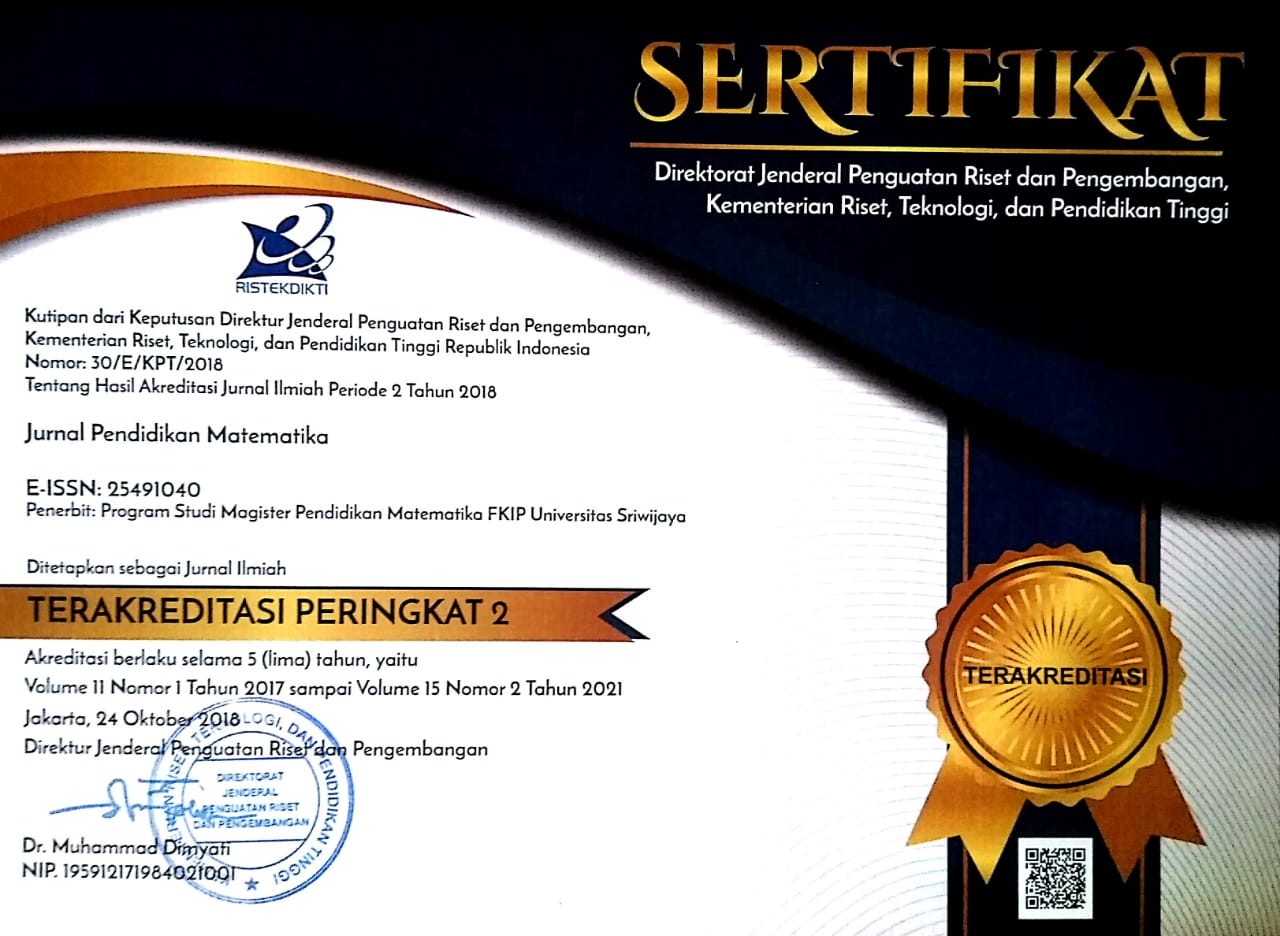Problem-solving Approach and Its Impact on Creative Thinking Ability of Prospective Mathematics Teachers
Abstract
This study aims to investigate the implementation of a problem-solving approach and its corresponding impact on the creative thinking ability of prospective mathematics teachers. A qualitative case study approach was used in this study in the form of observations of learning and teaching processes for geometry topics through the use of a problem-solving approach and of a written test involving 20 prospective mathematics teachers, in one of the state universities in Bandung, Indonesia. The results showed that the implemented problem-solving approach influenced prospective mathematics teachers’ creative thinking in solving problems. The use of different strategies showed prospective teachers’ creative thinking ability in problem-solving processes. The effect of the problem-solving approach on prospective mathematics teachers can be investigated further to obtain a more comprehensive understanding of creative thinking ability.
Keywords
Full Text:
PDFReferences
Almeida, L. S., Prieto, L. P., Ferrando, M., Oliveira, E., & Ferrándiz, C. (2008). Torrance test of creative thinking: The question of its construct validity. Thinking skills and creativity, 3(1), 53-58. https://doi.org/10.1016/j.tsc.2008.03.003
Barham, A. I. (2020). Investigating the development of pre-Service teachers' problem-solving strategies via problem-solving mathematics Classes. European Journal of Educational Research, 9(1), 129-141. https://doi.org/0.12973/eu-jer.9.1.129
Birgili, B. (2015). Creative and critical thinking skills in problem-based learning environments. Journal of Gifted Education and Creativity, 2(2), 71-80. Retrieved from https://dergipark.org.tr/en/pub/jgedc/issue/38680/449365
Cansoy, R., & Türkoglu, M. E. (2017). Examining the relationship between pre-service teachers' critical thinking disposition, problem solving skills and teacher self-efficacy. International Education Studies, 10(6), 23-35. https://doi.org/10.5539/ies.v10n6p23
Capraro, M. M., An, S. A., Ma, T., Rangel-Chavez, A. F., & Harbaugh, A. (2012). An investigation of preservice teachers’ use of guess and check in solving a semi open-ended mathematics problem. The Journal of Mathematical Behavior, 31(1), 105-116. https://doi.org/10.1016/j.jmathb.2011.10.002
Cenberci, S. (2018). The investigation of the creative thinking tendency of prospective mathematics teachers in terms of different variables. Journal of Education and Training Studies, 6(9), 78-85. https://doi.org/10.11114/jets.v6i9.3434
Dhayanti, D., Johar, R., & Zubainur, C. M. (2018). Improving students' critical and creative thinking through realistic mathematics education using Geometer's Sketchpad. Journal of Research and Advances in Mathematics Education, 3(1), 25-35. Retrieved from http://journals.ums.ac.id/index.php/jramathedu
Dickman, B. (2016). Looking back to support problem solving. The Mathematics Teacher, 110(1), 54-58. https://doi.org/10.5951/mathteacher.110.1.0054
Gridos, P., Avgerinos, E., Mamona-Downs, J., & Vlachou, R. (2022). Geometrical figure apprehension, construction of auxiliary lines, and multiple solutions in problem solving: Aspects of mathematical creativity in school geometry. International Journal of Science and Mathematics Education, 20(3), 619-636. https://doi.org/10.1007/s10763-021-10155-4
Jamaludin, A., & Hung, D. (2017). Problem-solving for STEM learning: Navigating games as narrativized problem spaces for 21st century competencies. Research and Practice in Technology Enhanced Learning, 12(1), 1-14. https://doi.org/10.1186/s41039-016-0038-0
Jupri, A., & Syaodih, E. (2016). Between formal and informal thinking: The use of algebra for solving geometry problems from the perspective of Van Hiele theory. Jurnal Pengajaran MIPA, 21(2), 108-113. https://doi.org/10.18269/jpmipa.v21i2.817
Jupri, A. (2017). From geometry to algebra and vice versa: Realistic mathematics education principles for analyzing geometry tasks. In AIP Conference Proceedings (Vol. 1830, No. 1, p. 050001). AIP Publishing LLC. https://doi.org/10.1063/1.4980938
Jupri, A., Gozali, S.M., & Usdiyana, D. (2020). An analysis of a geometry learning process: The case of proving area formulas. Prima: Jurnal Pendidikan Matematika, 4(2), 154-163. http://dx.doi.org/10.31000/prima.v4i2.2619
Koichu, B., & Leron, U. (2015). Proving as problem solving: The role of cognitive decoupling. The Journal of Mathematical Behavior, 40, 233-244. https://doi.org/10.1016/j.jmathb.2015.10.005
Leikin, R., & Pitta-Pantazi, D. (2013). Creativity and mathematics education: The state of the art. ZDM Mathematics Education, 45(2), 159-166. https://doi.org/10.1007/s11858-012-0459-1
Leong, Y. H., Toh, T. L., Tay, E. G., Quek, K. S., & Dindyal, J. (2012). Relooking ‘Look Back’: A student's attempt at problem solving using Polya's model. International Journal of Mathematical Education in Science and Technology, 43(3), 357-369. https://doi.org/10.1080/0020739X.2011.618558
Levav-Waynberg, A., & Leikin, R. (2012a). Using multiple solution tasks for the evaluation of students’ problem-solving performance in geometry. Canadian Journal of Science, Mathematics and Technology Education, 12(4), 311-333. https://doi.org/10.1080/14926156.2012.732191
Levav-Waynberg, A., & Leikin, R. (2012b). The role of multiple solution tasks in developing knowledge and creativity in geometry. The Journal of Mathematical Behavior, 31(1), 73-90. https://doi.org/10.1016/j.jmathb.2011.11.001
Mrayyan, S. (2016). Investigating mathematics teacher’s role to improve students’ creative thinking. American Journal of Educational Research, 4(1), 82-90. https://doi.org/10.12691/education-4-1-13
Palatnik, A., & Dreyfus, T. (2019). Students’ reasons for introducing auxiliary lines in proving situations. The Journal of Mathematical Behavior, 55, 100679. https://doi.org/10.1016/j.jmathb.2018.10.004
Polya, G. (1973). How to solve it: A new aspect of mathematical method (second edition). Princeton University Press. https://doi.org/10.2307/j.ctvc773pk
Schoenfeld, A. H. (2013). Reflections on problem solving theory and practice. The Mathematics Enthusiast, 10(1), 9-34. https://doi.org/10.54870/1551-3440.1258
Schoenfeld, A. H. (2016). Learning to think mathematically: Problem solving, metacognition, and sense making in mathematics. Journal of Education, 196(2), 1-38. https://doi.org/10.1177/002205741619600202
Silver, E. A. (1997). Fostering creativity through instruction rich in mathematical problem solving and problem posing. ZDM, 29(3), 75-80. https://doi.org/10.1007/s11858-997-0003-x
Taback, S. F. (1988). The wonder and creativity in “looking back” at problem solutions. The Mathematics Teacher, 81(6), 429-434. https://doi.org/10.5951/MT.81.6.0429
Tjoe, H. (2019). “Looking Back” to solve differently: Familiarity, fluency, and flexibility. In P. Liljedahl P., & M. Santos-Trigo (Eds.), Mathematical Problem Solving (pp. 3-20). ICME-13 Monographs. Springer, Cham. https://doi.org/10.1007/978-3-030-10472-6_1
Yuwono, M. R. (2016). Analysis of student difficulties in solving geometry problems based on Bloom's taxonomy and their alternative solutions [in Bahasa]. Beta: Jurnal Tadris Matematika, 9(2), 111–133. https://dx.doi.org/10.20414/betajtm.v9i2.7
DOI: https://doi.org/10.22342/jpm.16.3.17820.257-268
Jl. Srijaya Negara, Bukit Besar
Palembang - 30139 Indonesia
Jurnal Pendidikan Matematika is licensed under a Creative Commons Attribution-NonCommercial-ShareAlike 4.0 International License.
Indexed in:


